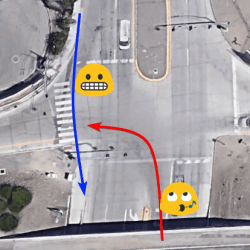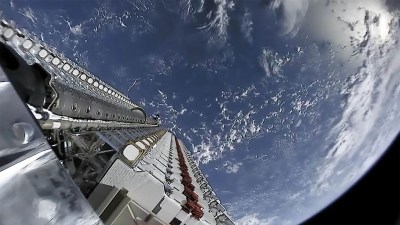
On a dark night in 2006 I was bicycle commuting to my office, oblivious to the countless man made objects orbiting in the sky above me at thousands of miles per hour. My attention was instead focused on a northbound car speeding through a freeway underpass at dozens of miles per hour, oblivious to my southbound headlamp. The car swerved into the left turn lane to get to the freeway on-ramp. The problem? I was only a few feet from crossing the entrance to that very on-ramp! As the car rushed through their left turn I was presented with a split second decision: slow, and possibly stop in the middle of the on-ramp, or just go for it and hope for the best.

By law I had the right of way. But this was no time to start discussing right of way with the driver of the vehicle that threatened to turn me into a dark spot on the road. I followed my gut instinct, and my legs burned in compliance as I sped across that on-ramp entrance with all my might. The oncoming car missed my rear wheel by mere feet! What could have ended in disaster and possibly even death had resulted in a near miss.
Terrestrial vehicles generally have laws and regulations that specify and enforce proper behavior. I had every right to expect the oncoming car be observant of their surroundings or to at least slow to a normal speed before making that turn. In contrast, traffic control in Earth orbit conjures up thoughts of bargain-crazed shoppers packed into a big box store on Black Friday.
So spacecraft traffic in orbit really a free-for-all? If there were stringent rules, how can they be enforced? Before we explore the answers to those questions, let’s examine the problem we’re here to discuss: stuff in space running into other stuff in space.
What Happens in Orbit Stays in Orbit
When an object is put into orbit, it does not readily come back to Earth until it is either forced out of orbit with a thruster or until orbital decay allows atmospheric drag to snatch it from the sky. As a result, functional satellites are only a portion of what orbits the Earth. Derelict satellites, debris from broken up spacecraft, and countless other man made objects too small to measure are hurtling above our heads this very moment.

In 2009 Russia’s Cosmos 2251, a decommissioned and uncontrolled satellite at 790 km altitude smashed into the Iridium 33 satellite. Their combined velocity was 42,000 km/h (26,000 mph). Although the Cosmos 2251 was inoperable, it couldn’t have gotten out of the way even if it wanted to — it had no maneuvering abilities even when it was healthy. By 2011, the collision could be held responsible for over 1,000 trackable pieces of debris larger than 10cm. Around this same time, the International Space Station had to maneuver to avoid collisions with some of this debris, with the crew taking shelter inside docked Soyuz capsules just in case. Everything turned out okay.
Of course stray Russian satellites are only the tip of an iceberg. Ascent stages, old satellites, and even debris from the intentional destruction of a satellite in 2007 are all in orbit, ready to collide with whatever gets in their way. Does this mean that Earth orbit is a wasteland of junk, uninhabitable by all but the most heavily armored spacecraft? Not quite.
Close Encounters of the Nerd Kind
When objects in orbit come within one kilometer of each other, it is considered a “close encounter”. One reason for this could be that it is very difficult to track small objects traveling at orbital speeds, and so there must be some room for error. This is especially true in Low Earth Orbit where the distance traveled in each orbit is less than that of a higher orbit. And it is Low Earth Orbit that is the most desirable for a large majority of communications satellite operators, especially those looking for low latency communications such as Starlink and OneWeb.

While Starlink, OneWeb, and other satellite operators have built satellites that can maneuver to avoid collisions, and even remove themselves from orbit, there are other problems that have caused close encounters and near-misses. The first is that many satellites lack any means to navigate, or their operators avoid such maneuvers to save on precious propellant that can’t be refilled.
The second problem is lack of communication and cooperation between satellite operators. In 2009, the ESA satellite Aeolus Earth was forced into a game of space chicken with a Starlink satellite that SpaceX had moved into a conflicting orbit. SpaceX held their ground, causing the ESA to expend precious fuel to thrust their spacecraft out of the way.
Some might point the finger at SpaceX and say that they acted poorly, and that’s a subject for a different article. But did SpaceX break any laws or rules? No.
More Launches, More Junk, More Problems
The discussion thus far has focused on some of the problems that have arisen because of space debris, conflicting orbital paths, and conflicting interests. Is there a solution? Probably.
To understand any possible solutions we have to take one more look at the core of the problem: Traffic control. When we think of traffic control, it is easiest to think of traffic that we’re most familiar with: Automobiles, Ships, and Aircraft. Each mode has its own governing entities that have oversight at multiple levels, be it local, regional, state, or national. International treaties and organizations have a say over what is acceptable on a global scale. Cooperation between all makes for relatively safe, controlled travel to and from any cooperating destination. What is at the core of all such traffic control in some way, shape or form? Right of way: The idea that one entity has the right to assert its path at the cost of another.
But once we reach the Kármán line that divides Earth’s atmosphere from outer space, all of that is out the window.
Where There’s a Will There’s a Right of Way
Taming the beast of orbital traffic control has been on the radar of regulators for many years. In 2002 the Inter-Agency Debris Coordination Committee issued a report (PDF) recommending that satellite operators should remove spacecraft and their ascent stages from commonly used orbits no more than 25 years after their missions are complete. Not all have abided by this rule though, and not all even have the ability.
Objects in orbits lower than 600 km will naturally follow the 25 year rule, but those at great altitude will need technology to aid in compliance. Currently there is no incentive to follow the 25 year rule, and there are no legally binding agreements in place to enforce any deterrents. With new operators popping up and incumbents launching dozens of loads a year, the problem continues to grow. What can be done?
A US government funded research firm called The Aerospace Corporation recently published a report on the subject. The report suggested various forms of incentive, ranging from direct government management and mandatory collision insurance to deorbit credits that can be traded like carbon credits.
We also can’t help but wonder if, as object density in various orbits increases, redefining what constitutes a close encounter will help ease fears. Could orbital traffic rules ever catch up to terrestrial law and enforcement, or will operators forever be dodging each other like poorly lit bicycles in the night? Will future space companies start getting demerits on their license for uncooperative behavior? Time will tell. We’d love to hear your thoughts on the subject in the comments below!
0 Commentaires